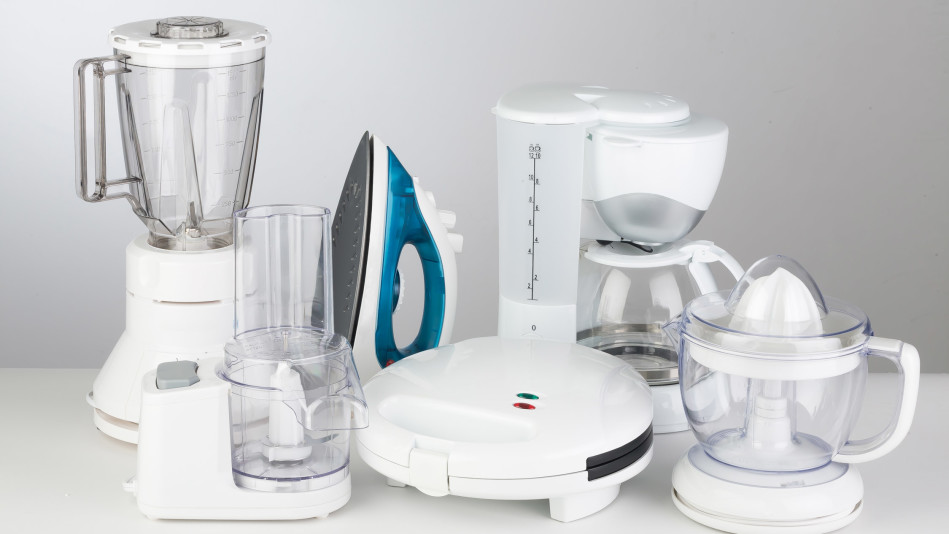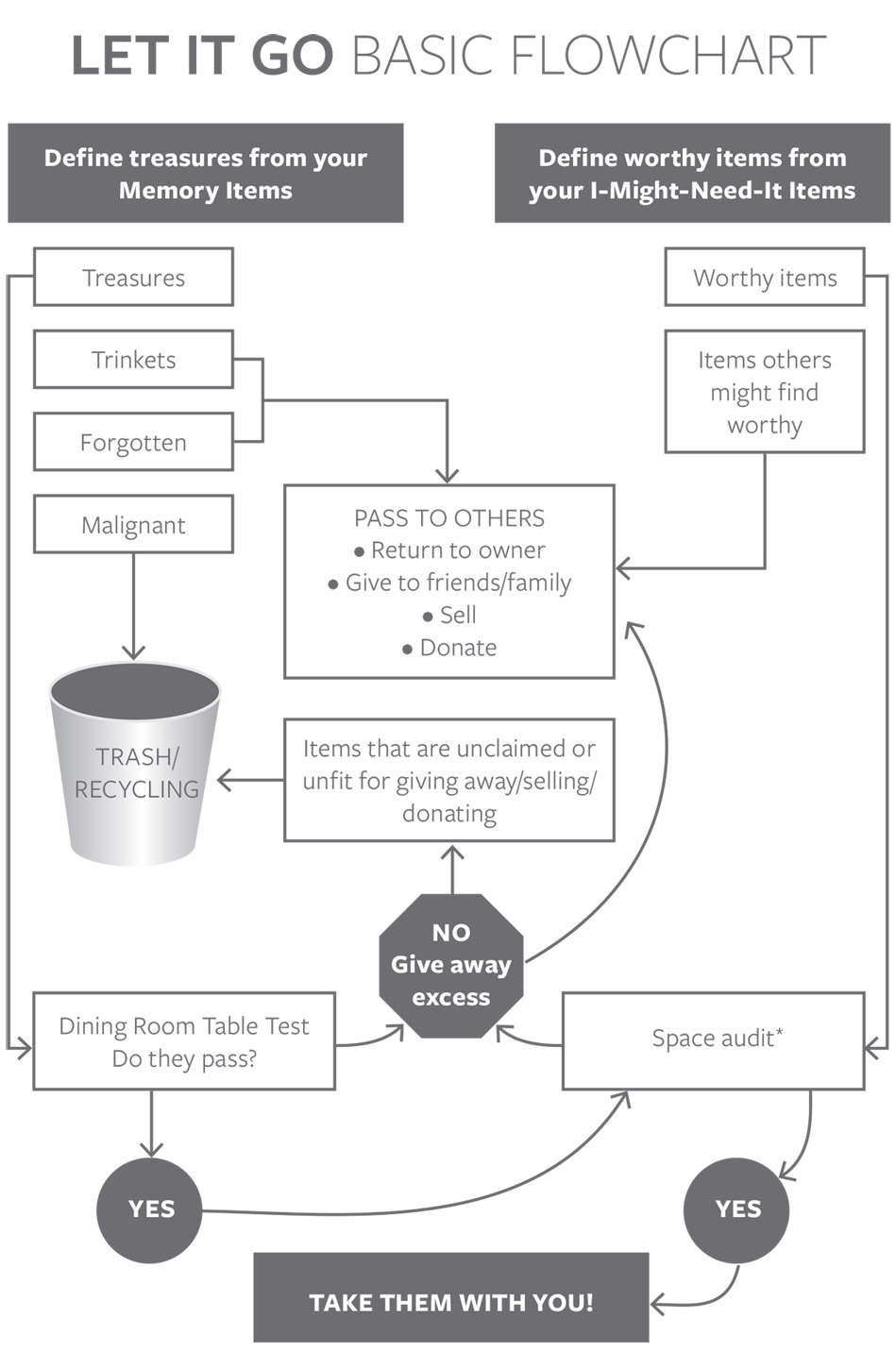Peter Walsh's Time-Saving Strategy for Getting Rid of Clutter
The organizing guru reveals the fastest way to clear your home of unnecessary items if you're downsizing or just need to tidy up, from his new book, Let It Go.

Photo: asiseeit/istockphoto
All the stuff you own will fit into one of three categories:
- Memory Items
- I-Might-Need-It Items
- Trash/Recycling
It’s easy to determine where each goes, and this will be your first task when you start doing the hands-on downsizing work.
Once you categorize each item, you can quickly determine whether you’ll keep it or let it go.
MEMORY ITEMS

Photo: Halfpoint/istockphoto
These are the things that remind you of important people, achievements, or events from your past. You have four kinds of Memory Items, and you’ll only keep the first kind: the treasures.
The treasures represent the peak experiences of your life and the most important moments from your family’s history. Their worth is not measured in money, but rather in the meaning and significance they hold for you or your family. You would continue
A treasure is truly irreplaceable. You can’t buy another in the store, and you probably wouldn’t even find this thing on eBay if you searched every day for a year. In my own case, a treasure would be my mother’s green dessert plate (which is insignificant and of no value to anyone else, but a real gem to me).
Even though you can quickly and easily picture many of your treasures, beware: Treasures can really slow your downsizing. That’s because people tend to have Treasure Creep. Even though they don’t really meet the true definition of treasures, many items still seem valuable enough to keep. Because you’re so afraid of losing a treasure, you’ll draw a wide perimeter around them and wind up including stuff that doesn’t really meet the criteria.
The fear of losing a treasure may also add to your nagging sense of dread about downsizing. But any fear you feel is going to slow down the process, and you don’t have time to waste. Remember: Treasures are few, important, and deeply meaningful. Once you identify your treasures and know they’ll be safely coming along with you, you’ll be able to apply your full attention to managing the next task.
In my experience, treasures represent about 5 percent of the objects you own, or even less. I definitely want you to keep these items, so long as you absolutely, positively verify that they are indeed the most important and special things you own. Spend some time thinking about the items that you’d truly give this label (that would be the best, the most significant, and the most memory-laden items that you own).
Once you make your selection, I want you to have the confidence to let these go from your mind. Since you’re sure you won’t be leaving behind what’s most important, there’s no reason that any worry about this group of items should be bogging down your decision-making processes.
You also have three other kinds of Memory Items. These you don’t take with you. These go somewhere else, whether you give them to friends, sell them in a garage sale, or have a cleansing ritual where you burn them in a bonfire.
The trinkets. These are items that you’ve collected from family holidays or celebrations that spark a smile but aren’t as important as the treasures. Examples: the Grand Canyon shot glass from your Arizona vacation or the broken pocketknife that grandpa owned that no one remembers him carrying. With you downsizing to a smaller home and beginning a new and exciting phase of your life, now is the time to let trinkets go.
The forgotten. These are the items that usually make you laugh and shrug your shoulders when someone asks where they came from. “I have no idea!” you’d say. If an item has no significance other than it’s been in your home longer than you can remember, then today’s the day to let it go, too. Examples: the paperback that a random person who had a crush on you gave you in high school, or leaves you pressed in wax paper on a random rainy Saturday in your youth.
The malignant. These are items that remind you of negative or painful moments. You hold on to them even though their very presence in your home triggers a memory or emotion that you’d prefer not to have. It’s time to let these go now. Take a moment to honor the younger version of yourself who survived this event, revisit any take-home lesson the object teaches you, and get rid of it now. Examples: the bike helmet you were wearing during the serious wreck, the journal you kept during a painful breakup, or the travel brochures for a vacation you had to cancel years ago so you could attend a funeral.
It’s possible that a friend or family member might want some of your trinkets and forgotten stuff. Or, these items might be valuable enough to sell. Whether it’s through gifting, donating, or selling, let these items go. And for the malignant items? You’re beginning a new day that has no place for anything that evokes a painful memory. Let them go . . . into the trash!
I-MIGHT-NEED-IT ITEMS

Photo: cjrfoto/istockphoto
These items have a useful function. The I-Might-Need-It category contains books and magazines on your shelves, clothes in your closet, food in your pantry, office supplies in your desk, and maybe even stuff in your kitchen junk drawer.
I’d estimate that about 80 percent of the stuff in a typical home falls into this category. But you’re not taking all of it!
You’re only going to bring one kind of I-Might-Need-It Items with you. I call these the worthy items. These are things that will reasonably and comfortably fit into the new space you have, which you use regularly and will likely continue to use after your move. A blender, for example, is a worthy item. Your winter coat is worthy, too.
But if you have a blender and a chopper and three other kitchen devices that turn food into tiny pieces, you probably don’t need them all. If you have three winter coats, you probably don’t need all of them—and if you’re moving to Key West, you may not need any.
Your worthy items must have a readily visible purpose in the next stage of your life, and you need adequate space to store them appropriately. You must have a better reason for keeping them than “I just don’t feel like getting rid of this yet” or “I can’t make a decision now, so I’ll box it up, take it with me, and deal with it later.” No doubt, dealing with worthy items is one of the most challenging parts of downsizing, but the effort is definitely worth the return.
Do you have a current ongoing need for this item (in other words, do you use it often)? Then it’s worthy. Do you have a specific plan to enjoy gadgets after your move that you don’t currently use? (For example, you’ve already checked out a golf course so you can swing your now-dusty clubs in retirement, or you’ve signed up for cooking classes so you can use your kitchen gear.) Then they’re worthy.
Are you at least 95 percent sure that you’ll want to offer an item to your kids (and they’ll want it) in the very near future? Then it’s worthy, too.
But thinking you might use an item in a year or two or that your kids will use it when they graduate from college in 3 years are not valid reasons to call an item worthy.
Now, keep in mind that you also need to establish that you’ll have room for these things at your next stop.
It’s quite likely that you’ll have several options for distributing I-Might-Need-It Items that you don’t want to take with you. That’s because these items might well be valuable or useful to someone else.
Maybe these are hand-me-down family items that you or your kids no longer need, but you’d like to offer to your nieces, nephews, and other extended family.
Or maybe a nonfamily member would want to buy your clothes, furniture, and other items you’re letting go. Should you sell this stuff online? Do you have time to arrange a garage sale? Do you have enough stuff for an estate sale? Or do you donate it to charity for a tax write-off? In the next section, I’ll walk you through these strategies.
TRASH/RECYCLING

Photo: seb_ra/istockphoto
The things that neither you nor anyone else needs to keep will represent, I suspect, about 15 percent of the stuff in your home.
This is the bag containing a handful of moldy grass seed from 2 years ago, the lone sock, the storage container without a lid, the stack of coffee-stained newspapers or magazines, and the pile of cleaning rags in the laundry cupboard. Trash is the clutter that accumulates—and perhaps even reproduces—under the sink, in the backs of closets, and in the other dark and overlooked crevices in your home.
If it clearly looks like trash, it goes in the trash/recycling pile as you’re downsizing. If you keep saying “no” when you try to put it into another category, it also goes in this pile. (“Is this a Memory or an I-Might-Need-It Item? Does anyone else want it? Can I sell it?”) Malignant items go in here, too.
So that's the quick-and-easy process of determining what you'll take and how to distribute the rest. Not so hard, is it?

*A space audit is essentially a rough blue print of your home.
*Dining room table test: However many treasures can fit on your dining room table is roughly how many you should have in your home. Your treasures commemorate the most loving, memorable, and triumphant moments of your life.

Excerpted from Let It Go: Downsizing Your Way to a Richer, Happier Life by Peter Walsh. Copyright ©2017 by Peter Walsh. Reprinted by permission of Rodale Books.
- Memory Items
- I-Might-Need-It Items
- Trash/Recycling
It’s easy to determine where each goes, and this will be your first task when you start doing the hands-on downsizing work.
Once you categorize each item, you can quickly determine whether you’ll keep it or let it go.
MEMORY ITEMS

Photo: Halfpoint/istockphoto
These are the things that remind you of important people, achievements, or events from your past. You have four kinds of Memory Items, and you’ll only keep the first kind: the treasures.
The treasures represent the peak experiences of your life and the most important moments from your family’s history. Their worth is not measured in money, but rather in the meaning and significance they hold for you or your family. You would continue
A treasure is truly irreplaceable. You can’t buy another in the store, and you probably wouldn’t even find this thing on eBay if you searched every day for a year. In my own case, a treasure would be my mother’s green dessert plate (which is insignificant and of no value to anyone else, but a real gem to me).
Even though you can quickly and easily picture many of your treasures, beware: Treasures can really slow your downsizing. That’s because people tend to have Treasure Creep. Even though they don’t really meet the true definition of treasures, many items still seem valuable enough to keep. Because you’re so afraid of losing a treasure, you’ll draw a wide perimeter around them and wind up including stuff that doesn’t really meet the criteria.
The fear of losing a treasure may also add to your nagging sense of dread about downsizing. But any fear you feel is going to slow down the process, and you don’t have time to waste. Remember: Treasures are few, important, and deeply meaningful. Once you identify your treasures and know they’ll be safely coming along with you, you’ll be able to apply your full attention to managing the next task.
In my experience, treasures represent about 5 percent of the objects you own, or even less. I definitely want you to keep these items, so long as you absolutely, positively verify that they are indeed the most important and special things you own. Spend some time thinking about the items that you’d truly give this label (that would be the best, the most significant, and the most memory-laden items that you own).
Once you make your selection, I want you to have the confidence to let these go from your mind. Since you’re sure you won’t be leaving behind what’s most important, there’s no reason that any worry about this group of items should be bogging down your decision-making processes.
You also have three other kinds of Memory Items. These you don’t take with you. These go somewhere else, whether you give them to friends, sell them in a garage sale, or have a cleansing ritual where you burn them in a bonfire.
The trinkets. These are items that you’ve collected from family holidays or celebrations that spark a smile but aren’t as important as the treasures. Examples: the Grand Canyon shot glass from your Arizona vacation or the broken pocketknife that grandpa owned that no one remembers him carrying. With you downsizing to a smaller home and beginning a new and exciting phase of your life, now is the time to let trinkets go.
The forgotten. These are the items that usually make you laugh and shrug your shoulders when someone asks where they came from. “I have no idea!” you’d say. If an item has no significance other than it’s been in your home longer than you can remember, then today’s the day to let it go, too. Examples: the paperback that a random person who had a crush on you gave you in high school, or leaves you pressed in wax paper on a random rainy Saturday in your youth.
The malignant. These are items that remind you of negative or painful moments. You hold on to them even though their very presence in your home triggers a memory or emotion that you’d prefer not to have. It’s time to let these go now. Take a moment to honor the younger version of yourself who survived this event, revisit any take-home lesson the object teaches you, and get rid of it now. Examples: the bike helmet you were wearing during the serious wreck, the journal you kept during a painful breakup, or the travel brochures for a vacation you had to cancel years ago so you could attend a funeral.
It’s possible that a friend or family member might want some of your trinkets and forgotten stuff. Or, these items might be valuable enough to sell. Whether it’s through gifting, donating, or selling, let these items go. And for the malignant items? You’re beginning a new day that has no place for anything that evokes a painful memory. Let them go . . . into the trash!
I-MIGHT-NEED-IT ITEMS

Photo: cjrfoto/istockphoto
These items have a useful function. The I-Might-Need-It category contains books and magazines on your shelves, clothes in your closet, food in your pantry, office supplies in your desk, and maybe even stuff in your kitchen junk drawer.
I’d estimate that about 80 percent of the stuff in a typical home falls into this category. But you’re not taking all of it!
You’re only going to bring one kind of I-Might-Need-It Items with you. I call these the worthy items. These are things that will reasonably and comfortably fit into the new space you have, which you use regularly and will likely continue to use after your move. A blender, for example, is a worthy item. Your winter coat is worthy, too.
But if you have a blender and a chopper and three other kitchen devices that turn food into tiny pieces, you probably don’t need them all. If you have three winter coats, you probably don’t need all of them—and if you’re moving to Key West, you may not need any.
Your worthy items must have a readily visible purpose in the next stage of your life, and you need adequate space to store them appropriately. You must have a better reason for keeping them than “I just don’t feel like getting rid of this yet” or “I can’t make a decision now, so I’ll box it up, take it with me, and deal with it later.” No doubt, dealing with worthy items is one of the most challenging parts of downsizing, but the effort is definitely worth the return.
Do you have a current ongoing need for this item (in other words, do you use it often)? Then it’s worthy. Do you have a specific plan to enjoy gadgets after your move that you don’t currently use? (For example, you’ve already checked out a golf course so you can swing your now-dusty clubs in retirement, or you’ve signed up for cooking classes so you can use your kitchen gear.) Then they’re worthy.
Are you at least 95 percent sure that you’ll want to offer an item to your kids (and they’ll want it) in the very near future? Then it’s worthy, too.
But thinking you might use an item in a year or two or that your kids will use it when they graduate from college in 3 years are not valid reasons to call an item worthy.
Now, keep in mind that you also need to establish that you’ll have room for these things at your next stop.
It’s quite likely that you’ll have several options for distributing I-Might-Need-It Items that you don’t want to take with you. That’s because these items might well be valuable or useful to someone else.
Maybe these are hand-me-down family items that you or your kids no longer need, but you’d like to offer to your nieces, nephews, and other extended family.
Or maybe a nonfamily member would want to buy your clothes, furniture, and other items you’re letting go. Should you sell this stuff online? Do you have time to arrange a garage sale? Do you have enough stuff for an estate sale? Or do you donate it to charity for a tax write-off? In the next section, I’ll walk you through these strategies.
TRASH/RECYCLING

Photo: seb_ra/istockphoto
The things that neither you nor anyone else needs to keep will represent, I suspect, about 15 percent of the stuff in your home.
This is the bag containing a handful of moldy grass seed from 2 years ago, the lone sock, the storage container without a lid, the stack of coffee-stained newspapers or magazines, and the pile of cleaning rags in the laundry cupboard. Trash is the clutter that accumulates—and perhaps even reproduces—under the sink, in the backs of closets, and in the other dark and overlooked crevices in your home.
If it clearly looks like trash, it goes in the trash/recycling pile as you’re downsizing. If you keep saying “no” when you try to put it into another category, it also goes in this pile. (“Is this a Memory or an I-Might-Need-It Item? Does anyone else want it? Can I sell it?”) Malignant items go in here, too.
So that's the quick-and-easy process of determining what you'll take and how to distribute the rest. Not so hard, is it?

*A space audit is essentially a rough blue print of your home.
*Dining room table test: However many treasures can fit on your dining room table is roughly how many you should have in your home. Your treasures commemorate the most loving, memorable, and triumphant moments of your life.

Excerpted from Let It Go: Downsizing Your Way to a Richer, Happier Life by Peter Walsh. Copyright ©2017 by Peter Walsh. Reprinted by permission of Rodale Books.



